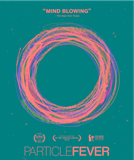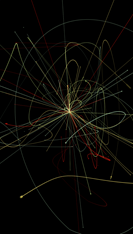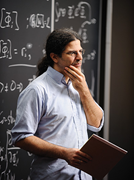Particles and the Nature of Nothing
David Kaplan
Professor of Physics & Astronomy
Johns Hopkins University
Producer, “Particle Fever,” PGA
About the Lecture

I will give a crash course on particle physics, collider experiments, and quantum field theory. I will show that on the cutting edge of particle physics is the search for the description of the vacuum of spacetime and the nature of the laws of physics. Particle colliders are one of a handful of ways to explore these laws, and the worlds largest, the Large Hadron Collider (LHC) outside of Geneva, Switzerland, will have collected unprecedented amounts of data by the time of this lecture, revealing answers — and undoubtedly bigger questions — about the nature of reality. The previous run of the LHC revealed the Higgs Boson particle. I will explain its significance, its impact on the field, and the justification for featuring it in a documentary film. I will also tell a joke that, at best, physicists will find amusing.

About the Speaker

David Kaplan is a theoretical particle physicist and professor at Johns Hopkins University. He received is A.B. at UC Berkeley and his PhD and the University of Washington. Before Hopkins, he held postdoctoral positions at the Stanford Linear Accelerator Center, the Argonne National Lab, and the University of Chicago. Early in his career, he was named a Outstanding Junior Investigator by the Department of Energy, and later a Fellow of the Sloan Foundation, the Kavli Foundation, and the American Physical Society. David Kaplan David also created and produced Particle Fever, a documentary film about the Large Hadron Collider for which he was nominated for Best Producer by the Producer’s Guild of America, and won a duPont Journalism Award, among other accolades. In addition, he has hosted science programs for the History Channel and National Geographic, and online videos for Quanta Magazine. He strongly recommends not being a filmmaker and physicist simultaneously, but continues to ignore his own advice.
Minutes
President Larry Millstein called the 2370th meeting of the Society to order at 8:10 p.m. He announced the order of business and welcomed new members. President Millstein presented a summary of the 32nd meeting of the Society, held in 1872. The minutes of the previous meeting were read and approved. President Millstein then introduced the speaker for the evening, David Kaplan, Professor of Physics and Astronomy at Johns Hopkins University and Producer of the documentary “Particle Fever”. His lecture was titled “Particles and the Nature of Nothing”.
Dr. Kaplan explained that we already know a great deal about the structure of matter, from atoms down to subatomic particles. Research at the Large Hadron Collider, which collides hydrogen atoms at a significant fraction of the speed of light, is therefore focused on understanding the medium in which atoms exist. The nothing, Dr. Kaplan explains, is made of something, and recent discoveries like the Higgs boson are part of the explanation of what forces are at play in the absence of matter, in the vacuum of space time.
To understand the promise of current research on the vacuum requires at least basic familiarity with quantum mechanics. Dr. Kaplan explained that quantum mechanics is essentially the study of waves. Waves in quantum physics can interact with one another in a way similar to sound waves or water waves. Where they meet they may amplify or cancel each other out. Even particles, such as electrons or photons, can behave as waves. The famous “double slit” experiment showed that light creates an interference pattern typical of waves—even when only a single photon is released at a time. The equally famous “uncertainty principle” indicates that particles are detected at a particular location with the probability as mapped by the behavior of the corresponding wave.
Dr. Kaplan then described quantum field theory using the analogy of a lake. Waves propagate across the surface of the water, carrying information and energy. Below the water, the analogy goes, there is another “lake”, but denser and more difficult to affect. By exciting the surface water sufficiently, we can also induce waves in this substrate. Greater and greater levels of energy let us affect deeper “lakes”. In the real world, these “lakes” correspond to the 17 fundamental fields of nature as described in the Standard Model, and waves in these lakes are the particles associated with these fields, such as the electron, photon, and lesser known quarks that form the structure of the protons and neutrons and thus of atoms.
Our most common experience with fields is the magnetic field, which only interacts with certain kinds of matter, which we call magnets. The Higgs field, on the other hand, interacts with all known matter, and the property it imparts is mass. The Higgs field became active at some point in the very early universe, after which particles could attract one another through gravitation and matter could begin to form. The Higgs field is one of the hardest to excite fields, which is why the LHC required such enormous energy to disturb it enough to create its associated particle, the Higgs boson, which was confirmed in 2012.
Dr. Kaplan explained that the Standard Model is now mathematically complete at the energies the LHC is using. It is therefore possible that we may not find any new fields or associated particles. One type of particle we may still find, however, would be those associated with dark matter. Dark matter is “matter” that is not made of atoms. Although it makes up 80% of the mass of the universe, it does not appear to interact with any known field except potentially the Higgs.
Because dark matter does not interact with light, we cannot see it directly, but its mass means we can use gravitational lensing to map its distribution. This reveals not only the large concentrations that are associated with visible matter, but also lower density filaments that aren’t associated with regular matter.
To actually detect dark matter, we may look for “missing” energy in particle collisions at the LHC, which could indicate that the missing energy was conserved in an undetected Weakly Interacting Massive Particle, or WIMP. Another approach is to set up detectors deep in mines where no other particle can reach, on the chance that a particle of dark matter may trigger the detector.
Dr. Kaplan concluded by noting that all of our theoretical work could be invalidated by a single new discovery, and that doing physics means living with that uncertainty.
After the conclusion of the talk, President Millstein invited questions from the audience.
One questioner asked how LHC scientists knew that they had discovered the Higgs. Dr. Kaplan explained that the Higgs was not directly detected because it decays instantly into byproduct particles. By repeatedly colliding particles and adding the energy of the byproducts, scientists identified a consistent outcome in the mass region around 126 GeV, which accorded with the particle predicted by the Standard Model. Because it fulfilled this role in the theory, scientists declared that the Higgs has been confirmed.
Another questioner asked what will succeed the LHC. Dr. Kaplan explained that the next 12 months will provide an order of magnitude more data from particle collisions. If this data suggests new interactions not predicted by current models, the LHC will remain at the forefront of physics. If it does not detect anything unexpected, that would indicate that new discoveries require an order of magnitude larger machine—potentially a 100 kilometer long accelerator—to ask the next question.
After the question and answer period, President Millstein thanked the speaker, made the usual housekeeping announcements, and invited guests to join the Society. At 10:16 p.m., President Millstein adjourned the 2370th meeting of the Society to the social hour.
Attendance: 56 for the film, and 168 for the lecture
The weather: Clear
The temperature: 7°C
Respectfully submitted,
Preston Thomas
External Communications Director